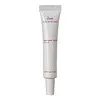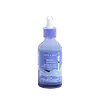What's inside
What's inside
 Key Ingredients
Key Ingredients

 Benefits
Benefits

 Concerns
Concerns

 Ingredients Side-by-side
Ingredients Side-by-side

Water
Skin ConditioningCetearyl Alcohol
EmollientNiacinamide
SmoothingGlyceryl Stearate
EmollientCaprylic/Capric Triglyceride
MaskingC12-15 Alkyl Benzoate
AntimicrobialCyclopentasiloxane
EmollientDimethicone
EmollientDimethicone/Vinyl Dimethicone Crosspolymer
Skin ConditioningCeteareth-29
CleansingCetyl Palmitate
EmollientCeteareth-12
EmulsifyingCeteareth-20
CleansingPEG-100
HumectantCaffeine
Skin ConditioningPropylene Glycol
HumectantGlycerin
HumectantDimethyl Sulfone
SolventAloe Barbadensis Leaf Juice
Skin ConditioningSaccharide Isomerate
HumectantPhenoxyethanol
PreservativeSodium Hyaluronate
HumectantPotassium Cetyl Phosphate
EmulsifyingMacadamia Ternifolia Seed Oil
EmollientTrehalose
HumectantSqualane
EmollientTocopheryl Acetate
AntioxidantBisabolol
MaskingRetinyl Palmitate
Skin ConditioningCopernicia Cerifera Cera
EmollientRetinol
Skin ConditioningPropanediol
SolventBHT
AntioxidantSodium Cocoamphoacetate
CleansingXanthan Gum
EmulsifyingCaprylyl Glycol
EmollientSodium Citrate
BufferingCitric Acid
BufferingDisodium EDTA
Water, Cetearyl Alcohol, Niacinamide, Glyceryl Stearate, Caprylic/Capric Triglyceride, C12-15 Alkyl Benzoate, Cyclopentasiloxane, Dimethicone, Dimethicone/Vinyl Dimethicone Crosspolymer, Ceteareth-29, Cetyl Palmitate, Ceteareth-12, Ceteareth-20, PEG-100, Caffeine, Propylene Glycol, Glycerin, Dimethyl Sulfone, Aloe Barbadensis Leaf Juice, Saccharide Isomerate, Phenoxyethanol, Sodium Hyaluronate, Potassium Cetyl Phosphate, Macadamia Ternifolia Seed Oil, Trehalose, Squalane, Tocopheryl Acetate, Bisabolol, Retinyl Palmitate, Copernicia Cerifera Cera, Retinol, Propanediol, BHT, Sodium Cocoamphoacetate, Xanthan Gum, Caprylyl Glycol, Sodium Citrate, Citric Acid, Disodium EDTA
Water
Skin ConditioningPropanediol
SolventVinyldimethicone
Glycerin
HumectantDipropylene Glycol
HumectantHydrogenated Lecithin
EmulsifyingGlycolipids
Skin ConditioningHydroxyacetophenone
AntioxidantBisabolol
MaskingCetyl Ethylhexanoate
EmollientMacadamia Ternifolia Seed Oil
EmollientSorbitan Stearate
EmulsifyingSodium Acrylate/Sodium Acryloyldimethyl Taurate Copolymer
Emulsion StabilisingPolyisobutene
Niacinamide
SmoothingPEG-5 Rapeseed Sterol
CleansingPolyglyceryl-10 Laurate
Skin Conditioning1,2-Hexanediol
Skin ConditioningCholesterol
EmollientPhytosteryl/Behenyl/Octyldodecyl Lauroyl Glutamate
Skin ConditioningDimethicone/Vinyl Dimethicone Crosspolymer
Skin ConditioningBakuchiol
AntimicrobialButyrospermum Parkii Butter
Skin ConditioningRetinol
Skin ConditioningTocopherol
AntioxidantDisodium EDTA
Ceramide NP
Skin ConditioningAcrylates/C10-30 Alkyl Acrylate Crosspolymer
Emulsion StabilisingDipotassium Glycyrrhizate
HumectantSucrose Cocoate
EmulsifyingSodium Hyaluronate
HumectantPentaerythrityl Tetra-Di-T-Butyl Hydroxyhydrocinnamate
AntioxidantRosa Damascena Flower Water
MaskingCaprylyl/Capryl Glucoside
CleansingAdenosine
Skin ConditioningSorbitan Oleate
EmulsifyingCetearyl Alcohol
EmollientStearic Acid
CleansingVanilla Planifolia Fruit Extract
Skin ConditioningPolyglutamic Acid
Skin ConditioningTromethamine
BufferingCamellia Sinensis Leaf Extract
AntimicrobialBenzotriazolyl Dodecyl P-Cresol
UV AbsorberGlyceryl Stearate
EmollientPolyglyceryl-10 Myristate
Skin ConditioningOleic Acid
EmollientButylene Glycol
HumectantSantalum Album Oil
MaskingCaprylyl Glycol
EmollientEthylhexylglycerin
Skin ConditioningCeramide Ns
Skin ConditioningPhytosphingosine
Skin ConditioningCarbomer
Emulsion StabilisingArginine
MaskingCeramide As
Skin ConditioningCeramide AP
Skin ConditioningCentella Asiatica Leaf Extract
Skin ConditioningCentella Asiatica Root Extract
Skin ConditioningCentella Asiatica Extract
CleansingSodium Dna
Skin ConditioningCeramide EOP
Skin ConditioningAcetyl Hexapeptide-8
HumectantPalmitoyl Pentapeptide-4
Skin ConditioningCopper Tripeptide-1
Skin ConditioningAsiatic Acid
Skin ConditioningAsiaticoside
AntioxidantMadecassic Acid
Skin ConditioningMadecassoside
AntioxidantWater, Propanediol, Vinyldimethicone, Glycerin, Dipropylene Glycol, Hydrogenated Lecithin, Glycolipids, Hydroxyacetophenone, Bisabolol, Cetyl Ethylhexanoate, Macadamia Ternifolia Seed Oil, Sorbitan Stearate, Sodium Acrylate/Sodium Acryloyldimethyl Taurate Copolymer, Polyisobutene, Niacinamide, PEG-5 Rapeseed Sterol, Polyglyceryl-10 Laurate, 1,2-Hexanediol, Cholesterol, Phytosteryl/Behenyl/Octyldodecyl Lauroyl Glutamate, Dimethicone/Vinyl Dimethicone Crosspolymer, Bakuchiol, Butyrospermum Parkii Butter, Retinol, Tocopherol, Disodium EDTA, Ceramide NP, Acrylates/C10-30 Alkyl Acrylate Crosspolymer, Dipotassium Glycyrrhizate, Sucrose Cocoate, Sodium Hyaluronate, Pentaerythrityl Tetra-Di-T-Butyl Hydroxyhydrocinnamate, Rosa Damascena Flower Water, Caprylyl/Capryl Glucoside, Adenosine, Sorbitan Oleate, Cetearyl Alcohol, Stearic Acid, Vanilla Planifolia Fruit Extract, Polyglutamic Acid, Tromethamine, Camellia Sinensis Leaf Extract, Benzotriazolyl Dodecyl P-Cresol, Glyceryl Stearate, Polyglyceryl-10 Myristate, Oleic Acid, Butylene Glycol, Santalum Album Oil, Caprylyl Glycol, Ethylhexylglycerin, Ceramide Ns, Phytosphingosine, Carbomer, Arginine, Ceramide As, Ceramide AP, Centella Asiatica Leaf Extract, Centella Asiatica Root Extract, Centella Asiatica Extract, Sodium Dna, Ceramide EOP, Acetyl Hexapeptide-8, Palmitoyl Pentapeptide-4, Copper Tripeptide-1, Asiatic Acid, Asiaticoside, Madecassic Acid, Madecassoside
Ingredients Explained
These ingredients are found in both products.
Ingredients higher up in an ingredient list are typically present in a larger amount.
Bisabolol is famous for its skin soothing properties. It does this by blocking inflammatory signals, helping to reduce your body's reaction to irritation.
This ingredient also interferes with the process of hyperpigmentation. This can help with reducing dark spots and uneven tone.
Bisabolol is an antioxidant. Antioxidants help fight free-radicals. Free-radicals are molecules that may damage your skin cells. By fighting these free-radicals, Bisabolol may slow down signs of aging.
Studies have shown Bisabolol to have antimicrobial properties and may be a fungicide. These properties help preserve a product's shelf life.
All these properties makes bisabolol a great skin barrier helper ingredient.
Bisabolol also helps the absorption of other ingredients.
Note: Synthetic Bisabolol has been shown to be less effective.
Learn more about BisabololCaprylyl Glycol is a humectant and emollient, meaning it attracts and preserves moisture.
It is a common ingredient in many products, especially those designed to hydrate skin. The primary benefits are retaining moisture, skin softening, and promoting a healthy skin barrier.
Though Caprylyl Glycol is an alcohol derived from fatty acids, it is not the kind that can dry out skin.
This ingredient is also used as a preservative to extend the life of products. It has slight antimicrobial properties.
Learn more about Caprylyl GlycolCetearyl alcohol is a mixture of two fatty alcohols: cetyl alcohol and stearyl alcohol. It is mainly used as an emulsifier. Emulsifiers help prevent the separation of oils and products. Due to its composition, it can also be used to thicken a product or help create foam.
Cetearyl alcohol is an emollient. Emollients help soothe and hydrate the skin by trapping moisture.
Studies show Cetearyl alcohol is non-toxic and non-irritating. The FDA allows products labeled "alcohol-free" to have fatty alcohols.
This ingredient is usually derived from plant oils such as palm, vegetable, or coconut oils. There is debate on whether this ingredient will cause acne.
Due to the fatty acid base, this ingredient may not be Malassezia folliculitis safe.
Learn more about Cetearyl AlcoholThis ingredient is a silicone used to improve the texture of products and absorb oil. It does not get absorbed into the skin.
Like other silicones, Dimethicone/Vinyl Dimethicone Crosspolymer helps condition the skin by creating a barrier. In this sense, it can act as an emollient and trap moisture in.
This ingredient is a type of elastomer.
Learn more about Dimethicone/Vinyl Dimethicone CrosspolymerDisodium EDTA plays a role in making products more stable by aiding other preservatives.
It is a chelating agent, meaning it neutralizes metal ions that may be found in a product.
Disodium EDTA is a salt of edetic acid and is found to be safe in cosmetic ingredients.
Learn more about Disodium EDTAGlycerin is already naturally found in your skin. It helps moisturize and protect your skin.
A study from 2016 found glycerin to be more effective as a humectant than AHAs and hyaluronic acid.
As a humectant, it helps the skin stay hydrated by pulling moisture to your skin. The low molecular weight of glycerin allows it to pull moisture into the deeper layers of your skin.
Hydrated skin improves your skin barrier; Your skin barrier helps protect against irritants and bacteria.
Glycerin has also been found to have antimicrobial and antiviral properties. Due to these properties, glycerin is often used in wound and burn treatments.
In cosmetics, glycerin is usually derived from plants such as soybean or palm. However, it can also be sourced from animals, such as tallow or animal fat.
This ingredient is organic, colorless, odorless, and non-toxic.
Glycerin is the name for this ingredient in American English. British English uses Glycerol/Glycerine.
Learn more about GlycerinGlyceryl Stearate is a mix of glycerin and stearic acid.
It is used to stabilize the mixing of water and oil ingredients. By preventing these ingredients from separating, it can help elongate shelf life. It can also help thicken the product's texture.
As an emollient, it helps soften skin and supports barrier-replenishing ingredients.
In cosmetics, Glyceryl Stearate is often made from vegetable oils or synthetically produced.
This ingredient may not be fungal-acne safe
Fun fact: The human body also creates Glyceryl Stearate naturally.
Learn more about Glyceryl StearateMacadamia Ternifolia Seed Oil is the fixed oil obtained from Macadamia nut.
Macadamia seed oil is rich in fatty acids, including oleic acid (45-75%), palmitoleic acid (7-33%), and palmitic acid (6-12%). They also contain various B vitamins, iron, and magnesium.
Palmitoleic acid has been shown to help soothe inflammation and promote wound healing. It is also naturally found in the fat of our skin.
Macadamia seed oil may not be malassezia folliculitis, or fungal-acne, safe.
Learn more about Macadamia Ternifolia Seed OilNiacinamide is a multitasking form of vitamin B3 that strengthens the skin barrier, reduces pores and dark spots, regulates oil, and improves signs of aging.
And the best part? It's gentle and well-tolerated by most skin types, including sensitive and reactive skin.
You might have heard of "niacin flush", or the reddening of skin that causes itchiness. Niacinamide has not been found to cause this.
In very rare cases, some individuals may not be able to tolerate niacinamide at all or experience an allergic reaction to it.
If you are experiencing flaking, irritation, and dryness with this ingredient, be sure to double check all your products as this ingredient can be found in all categories of skincare.
When incorporating niacinamide into your routine, look out for concentration amounts. Typically, 5% niacinamide provides benefits such as fading dark spots. However, if you have sensitive skin, it is better to begin with a smaller concentration.
When you apply niacinamide to your skin, your body converts it into nicotinamide adenine dinucleotide (NAD). NAD is an essential coenzyme that is already found in your cells as "fuel" and powers countless biological processes.
In your skin, NAD helps repair cell damage, produce new healthy cells, support collagen production, strengthen the skin barrier, and fight environmental stressors (like UV and pollution).
Our natural NAD levels start to decline with age, leading to slower skin repair, visible aging, and a weaker skin barrier. By providing your skin niacinamide, you're recharging your skin's NAD levels. This leads to stronger, healthier, and younger looking skin.
Another name for vitamin B3 is nicotinamide. This vitamin is water-soluble and our bodies don't store it. We obtain Vitamin B3 from either food or skincare. Meat, fish, wheat, yeast, and leafy greens contain vitamin B3.
The type of niacinamide used in skincare is synthetically created.
Learn more about NiacinamidePropanediol is an all-star ingredient. It softens, hydrates, and smooths the skin.
It’s often used to:
Propanediol is not likely to cause sensitivity and considered safe to use. It is derived from corn or petroleum with a clear color and no scent.
Learn more about PropanediolRetinol is a gold-standard ingredient for anti-aging. It is a form of Vitamin A and belongs to the class of retinoids that also includes tretinoin.
Why is retinol famous?
It has the most scientific studies backing up its skin benefits out of all the non-prescription ingredients.
Retinol is proven to:
This is why retinol is effective at removing wrinkles, fading dark spots, treating acne, and reducing the appearance of pores.
Studies show retinol is less effective when exposed to UV. Be sure to look for appropriate packaging to keep your retinol potent (similar to Vitamin C).
Using retinol or any retinoids will increase sun-sensitivity in the first few months. Though studies show retinoids increase your skin's natural SPF with continuous use, it is best to always wear sunscreen and sun-protection.
We recommend speaking with a medical professional about using this ingredient during pregnancy.
Retinol may cause irritation in some people, so be sure to patch test. Experts recommend 'ramping up' retinol use: start using this ingredient once a week and work up to using it daily.
Read about Tretinoin
Learn more about RetinolSodium Hyaluronate is hyaluronic acid's salt form. It is commonly derived from the sodium salt of hyaluronic acid.
Like hyaluronic acid, it is great at holding water and acts as a humectant. This makes it a great skin hydrating ingredient.
Sodium Hyaluronate is naturally occurring in our bodies and is mostly found in eye fluid and joints.
These are some other common types of Hyaluronic Acid:
Learn more about Sodium HyaluronateWater. It's the most common cosmetic ingredient of all. You'll usually see it at the top of ingredient lists, meaning that it makes up the largest part of the product.
So why is it so popular? Water most often acts as a solvent - this means that it helps dissolve other ingredients into the formulation.
You'll also recognize water as that liquid we all need to stay alive. If you see this, drink a glass of water. Stay hydrated!
Learn more about Water